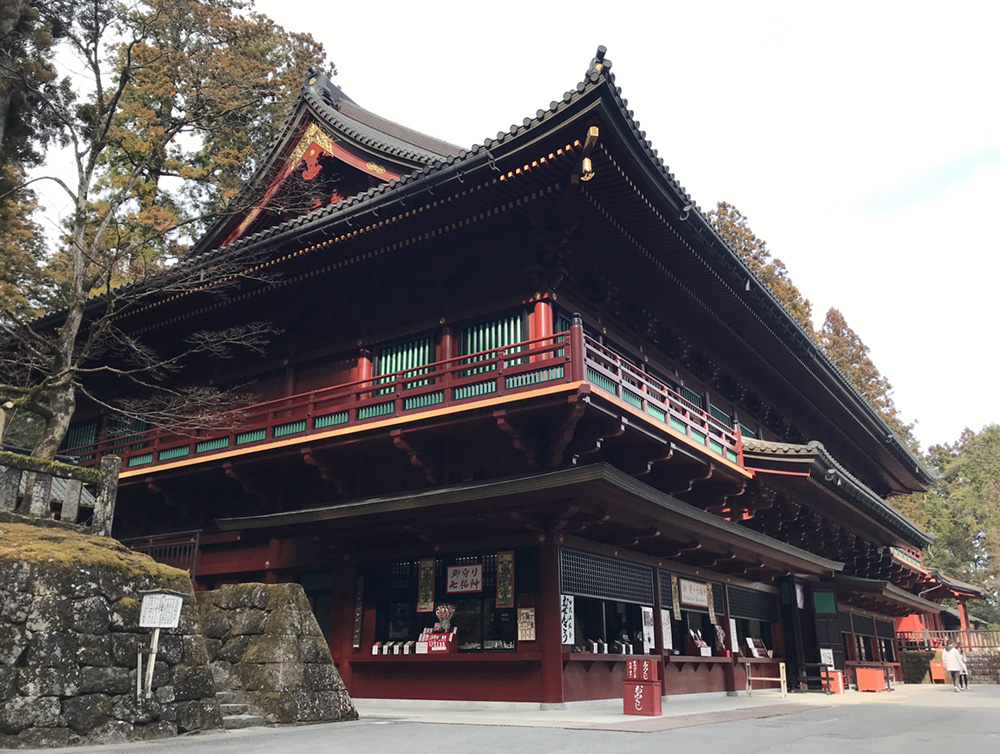大護摩堂
Daigomado, Hall for the Goma Fire Ritual
大护摩堂
大護摩堂
고마도, 호마의식을 위한 곳
Gomadō, hall pour le rituel de feu goma
Gomado, Halle für das Goma-Feuerritual
Gomado, Pabellón del Ritual del Fuego de Goma
โกมะโด (Gomado) วิหารที่ใช้สำหรับพิธีกรรมบูชาไฟโกมะ

「護摩祈願」を行うお堂です。護摩とは修行者が「火」を焚いて魔障を払い、供物を捧げて仏を供養することで、さまざまな利益をもたらす修行です。
日光山の100棟以上の歴史的建造物は、すべてが木造建築の指定文化財で、火の取り扱いに制限があり、多くの参拝者の要望に応えるため平成10年(1998)に新築されました。
堂内には不動明王を中尊とした五大明王(平安中期作)を中心に、七福神や祖師像など30体の尊像が祀られており、年間を通じて毎朝7時30分を第一座として1日数回の護摩祈願を行っています。
This hall was built for the performance of the Goma fire ritual. In this esoteric Buddhist rite, prayers written on paper or small tablets of wood are transmitted to the Buddhist deities by being burnt in a sacred fire. Given the risk posed by carrying out such a ritual in any of the important historical wooden structures at the Rinnoji, it was decided to construct this new special-purpose hall.
Although built in a traditional architectural style, the structure is made from modern steel-reinforced concrete. Aside from providing protection in the event of an earthquake, these incombustible materials also serve to prevent fires from spreading to nearby cultural properties should there be an accident during the ritual. Built in 1998, it is the newest structure at the Rinnoji Temple.
这座大殿是为表演护摩火祭而建。在这种深奥的佛教仪式中,写在纸上或小木片上的祈祷经圣火燃烧后会传递给佛教神明。考虑到在轮王寺这座重要的历史性木造建筑中进行这种仪式所带来的风险,因此决定为了这个特殊的用途建造了这个新的大殿。
尽管以传统的建筑风格建造,但建筑是由现代的钢筋混凝土建成。除了在地震发生时提供保护外,这些不可燃的材料还可以防止在仪式中发生意外时火灾蔓延到附近的文化财产上。建于1998年,是轮王寺中最新的建筑。
這座大殿是為表演護摩火祭而建。在這種深奧的佛教儀式中,寫在紙上或小木片上的祈禱經聖火燃燒後會傳遞給佛教神明。考慮到在輪王寺這座重要的歷史性木造建築中進行這種儀式所帶來的風險,因此決定為了這個特殊的用途建造了這個新的大殿。
儘管以傳統的建築風格建造,但建築是由現代的鋼筋混凝土建成。除了在地震發生時提供保護外,這些不可燃的材料還可以防止在儀式中發生意外時火災蔓延到附近的文化財產上。建於1998年,是輪王寺中最新的建築。
호마의식을 진행하기 위해 지어진 건물입니다. 밀교의 의식으로 종이나 작은 나무 판에 적힌 기도문을 신성한 불에 태워 불교의 신들에게 전달합니다. 린노지의 중요한 역사적 목조 건축물에서 호마의식을 수행할 때 발생할 수 있는 위험을 감안하여 특수한 목적의 건물을 새로 건설하게 되었습니다.
전통 건축양식으로 지어졌지만 구조는 현대 철근 콘크리트로 되어 있습니다. 철근 콘크리트는 지진 발생시 보호 기능을 하는 것은 물론 불연성 소재여서 의식을 진행하는 도중에 사고가 발생했을 때 인근 문화재로 화재가 확산되는 것을 방지합니다. 린노지 사찰에서 가장 최신 건물로 1998년에 지어졌습니다.
Ce hall fut construit pour la représentation du rituel de feu goma. Dans ce rite bouddhiste ésotérique, des prières écrites sur du papier ou sur de petites tablettes de bois sont transmises aux divinités bouddhistes en étant brûlées dans un feu sacré. Compte tenu du risque posé par la réalisation d'un tel rituel dans l'une des plus importantes structures historiques en bois du Rinnō-ji, il fut décidé de construire ce nouveau hall spécialement à cette fin.
Bien que construite dans un style architectural traditionnel, la structure est en béton armé moderne. En plus de fournir une protection en cas de tremblement de terre, ces matériaux ininflammables servent également à empêcher les incendies de se propager aux biens culturels voisins en cas d'accident pendant le rituel. Construite en 1998, cette structure est la plus récente du temple Rinnō-ji.
Die Halle wurde für die Durchführung des Goma-Feuerrituals gebaut. Bei diesem esoterisch buddhistischen Ritual werden Gebete, die auf Papier oder kleine Holztafeln geschrieben werden, an buddhistische Gottheiten gerichtet, indem sie in einem heiligen Feuer verbrannt werden. Angesichts des Risikos, das eine Durchführung eines solchen Rituals in einer der historisch wichtigen Holzkonstruktionen des Rinnoji mit sich bringt, wurde der Bau dieser neuen Spezialhalle beschlossen.
Obwohl sie im traditionellen Baustil errichtet wurde, besteht die Struktur aus modernem Stahlbeton. Dieses nicht entzündbare Material bietet nicht nur Schutz im Falle eines Erdbebens, sondern verhindert auch, dass sich Brände auf nahegelegene Kulturgüter ausbreiten, falls es während des Rituals zu einem Unfall kommt. Im Jahr 1998 erbaut, ist sie das neueste Bauwerk im Rinnoji-Tempel.
Este pabellón se construyó para efectuar el ritual del fuego de Goma. En este rito budista esotérico, las oraciones escritas en papel o pequeñas tablillas de madera se transmiten a las deidades budistas quemándolas en un fuego sagrado. Dado el riesgo que representaba la ejecución de un ritual de este tipo en cualquiera de las importantes estructuras históricas de madera del Rinnoji, se decidió construir este nuevo pabellón expresamente para dicho fin.
Aunque está construido en un estilo arquitectónico tradicional, su estructura se compone de moderno hormigón armado con acero. Además de brindar protección en caso de terremoto, sus materiales ignífugos también sirven para evitar que evitar que los incendios se propaguen a los bienes culturales cercanos si ocurre un accidente durante el ritual. Erigido en 1998, este pabellón es la estructura más nueva del templo Rinnoji.
วิหารนี้สร้างขึ้นเพื่อประกอบพิธีกรรมบูชาไฟโกมะ ในพิธีกรรมทางพระพุทธศาสนาวัชรยานนี้ คำอธิษฐานที่เขียนบนกระดาษหรือแผ่นไม้เล็ก ๆ จะถูกส่งไปยังเทพในพระพุทธศาสนาโดยเอาไปเผาในไฟศักดิ์สิทธิ์ ด้วยความเสี่ยงที่อาจเกิดขึ้นต่อโครงสร้างไม้ของวัดรินโนจิ (Rinnoji) ที่มีความสำคัญทางประวัติศาสตร์จากการประกอบพิธีกรรมดังกล่าว จึงมีการตัดสินใจสร้างวิหารแห่งใหม่ขึ้นเพื่อใช้วัตถุประสงค์พิเศษนี้
แม้ว่าจะสร้างในรูปแบบสถาปัตยกรรมดั้งเดิม แต่โครงสร้างก็ทำจากคอนกรีตเสริมเหล็กที่ทันสมัย นอกจากการป้องกันที่จัดเตรียมไว้ในกรณีที่เกิดแผ่นดินไหวแล้ว วัสดุที่ไม่ติดไฟเหล่านี้ยังช่วยป้องกันไม่ให้ไฟลุกลามไปยังมรดกทางวัฒนธรรมในบริเวณใกล้เคียง หากเกิดอุบัติเหตุในระหว่างพิธีกรรม เป็นโครงสร้างใหม่ล่าสุดที่สร้างขึ้นในปี ค.ศ. 1998 ที่วัดรินโนจิ
